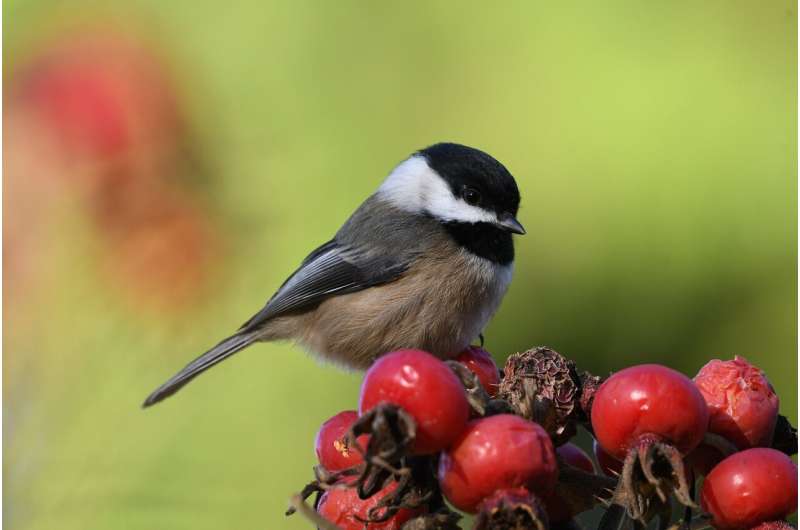
Researchers at the Zuckerman Mind Brain Behavior Institute at Columbia University discovered that hippocampal place cells in black-capped chickadees fire when the bird merely gazes at a distant location, revealing a unified spatial memory process driven by vision.
Many animals rely on vision to trigger recall for where food is hidden or to chart a course toward distant goals. Place cells in the hippocampus form the neural basis for such spatial memory, firing when an animal enters a specific location.
Earlier studies in primates found some hippocampal activity linked to where the eyes were directed, though recordings typically involved stationary animals.
Freely tracking eye movements during active behavior poses persistent technical obstacles as common laboratory models, such as rodents, lack precise gaze control. Researchers have not previously resolved how hippocampal place coding connects to the act of visually searching locations from afar.
In the study, “Remote activation of place codes by gaze in a highly visual animal,” published in Nature, researchers designed experiments to investigate whether hippocampal place cells in black-capped chickadees activate during visual fixation on distant spatial targets.
Eight black-capped chickadees participated in the experiments, which took place in a 61-centimeter arena containing five identical sites equipped with perches, light cues and motorized feeders.
Researchers adapted a multi-camera tracking system that triangulated infrared-reflective markers on each bird’s head to record head position during free movement.
A separate dual-camera video-oculography system estimated the pupillary axis by capturing corneal reflections, enabling calibration of eye-in-head orientation. Gaze direction was determined primarily by head orientation because chickadees exhibit minimal independent eye movement.
Birds performed a discrete visual search task in which a light cue signaled the rewarded site after a random delay, and a closed-loop version where the cue activated only when the bird gazed at the correct target. Silicon probes implanted in the anterior hippocampus recorded neural activity.
Recordings from 1,929 excitatory hippocampal neurons showed that 62% were tuned to the bird’s location during navigation and 57% responded to gaze direction during stationary visual search.
Among neurons classified as place-tuned, 75% also exhibited significant gaze tuning (changes in firing rate when the bird fixated on different target sites). Preferred locations for place and gaze responses overlapped in 95% of cells with strong selectivity. Contralateral (opposite-side) gaze accounted for most of the tuning, with neurons firing when the eye opposite the recording hemisphere fixated on a target.
Neural responses during fast head movements (called head saccades) displayed a biphasic pattern: an early component emerged before the bird’s gaze landed on the preferred target, and a later component corresponded to visual input.
Inhibitory interneurons clustered into two groups with firing phases roughly 180 degrees apart, creating a quasiperiodic oscillation linked to head saccades.
Results indicate that hippocampal activity encodes a combination of prediction and sensory response tied to where the bird directs visual attention. Findings suggest that saccadic head movements synchronize memory-related neural activity multiple times per second.
Researchers conclude that place coding and gaze coding form a unified process through which the hippocampus represents locations relevant to the animal at each moment. Such representations allow both the formation of spatial memories when a bird visits a site and the recall of those memories from afar upon return.
Written for you by our author Justin Jackson,
edited by Sadie Harley, and fact-checked and reviewed by Andrew Zinin—this article is the result of careful human work. We rely on readers like you to keep independent science journalism alive.
If this reporting matters to you,
please consider a donation (especially monthly).
You’ll get an ad-free account as a thank-you.
More information:
Hannah L. Payne et al, Remote activation of place codes by gaze in a highly visual animal, Nature (2025). DOI: 10.1038/s41586-025-09101-z
Uwe Mayer, ‘Place’ neurons recognize the same spot from close by and far away, Nature (2025). DOI: 10.1038/d41586-025-01716-6
© 2025 Science X Network
Citation:
Chickadees recall places by simply looking from afar (2025, July 5)
retrieved 5 July 2025
from
This document is subject to copyright. Apart from any fair dealing for the purpose of private study or research, no
part may be reproduced without the written permission. The content is provided for information purposes only.

